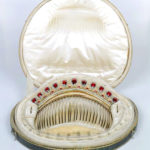The New Woman: Changes in Fashion and Aspiration in the 1920s
Editor’s Note: Support the Maryland Historical Society by participating in our Adopt A Box! program. For as little as $100 you can help preserve these treasures for future generations.
By: Anna-Maria Hand
In the 1920s, womenswear saw an enormous change in length and style. The hemline of dresses continued to shorten from floor length to above the ankle in 1910-20, but they reached an all time high in the 1920s. Although hemlines were short, the androgyny of “La Garçonne” look remained. The haute couture garçonne look included short bob hairstyles, red lipstick, kohl-lined eyes, loose fitted dresses with a knee length hem and a dropped waistline.
Fashion wasn't the only change for women in the 1920s. During WWI, some women had to work outside the household to support their families. After the war, women continued (excitedly) to work outside the home. They also participated in sports, driving, swimming, a higher education, a career, and romantic relationships. This new woman was active, and she demanded attention.
The collection of 1920s dresses found thus far show how exciting and stylish these women were. Fortunately, most of these 1920s donations were given by the original wearer, which makes it easier to pinpoint the provenance.
This mulberry red velvet evening dress from 1925, donated by Mrs. Herman Cohn, shows the difference in fabrics used throughout this decade. Use of synthetic materials such as rayon were extremely common.
This fantastic sequined flapper dress donated by Mrs. Morgan Rowland Jr. from 1925, is completely representative of the time. This dress definitely sparkled throughout the evening. A downside to this dress, however, is that it is entirely made from netting with applied beading and sequins, which makes it extremely fragile.
- Garnet Tiara worn by Elizabeth Patterson Bonaparte, circa 1803-5, Maryland Historical Society, Gift of Mrs. Charles Joseph Bonaparte, xx.5.295
This 1925 dress is a combination of silk velvet, added beading, lace, and came with an inner slip attached. It also has a label reading, “Max Cohen Inc. – Paris/New York”. It was donated by Mrs. Hermann E. Cohn. Again, the material used, and the weight of the beading makes the dress extremely fragile.
These dresses represented the new woman in the 1920s with their extravagance and boldness; however, these luxuries only lasted the decade. For almost two decades, through The Great Depression and WWII, affordable and functional dresses were maintained. It wasn't until Christian Dior's New Look in 1947, that fashion regained the supremacy of haute couture.
Learn more how you can preserve these treasures by participating in our Adopt A Box! program. We thank you for your support!
Resources
Koga, Reiko. The Influence of haute couture: Fashion in the First Half of the 20th Century. Fashion: The Collection of the Kyoto Costume Institute. Vol. 2. Taschen, 2007.


